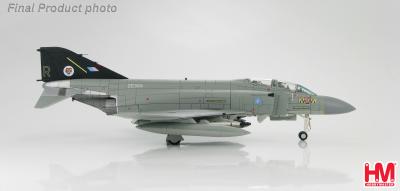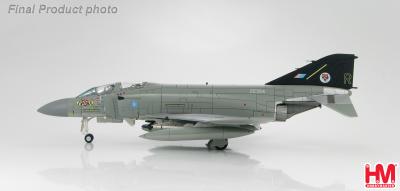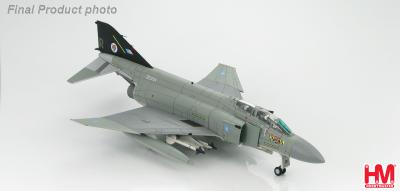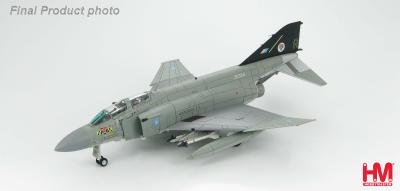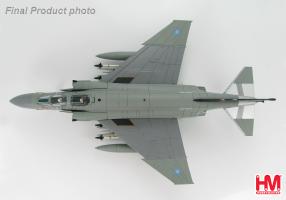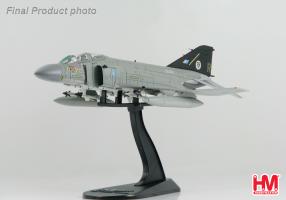Hobby Master Archive
Air Power Jets 1/72
F-4
Exclusive - F-4J UK Phantom II 74 Squadron, RAF 1990 ZE354
Specification for the F- 4J Performance Engines: 2 X General Electric J79-GE-8B/8C/10 turbojets, 11,870 lb.s.t dry, 17,900 lb. s.t. with afterburner. Maximum speed: 1,584 mph at 48,000 ft. (Mach 2.4), 875 mph at sea level (Mach 1.15). Initial climb rate: 41,250 fpm. Service ceiling: 70,000 ft. Combat ceiling: 54,700 ft. Combat range: 596 miles, maximum range 1,956 miles with maximum external fuel.
Weights 30,770 lbs empty. 46,833 lbs gross. 41,399 lbs combat weight, Dimensions Wingspan: 38 ft. 5 in. Wing area: 530 square ft. Length: 58 ft. 3.75 in. Height: 16 ft. 3 in.
Fuel Maximum internal fuel: in fuselage tanks 1,347 US gal. Internal wing tanks: 630 gal. Maximum external fuel: 3,317 US gal. 600 US gal in a centerline tank, 370 US gal in each of two tanks that could be carried underneath the outer under wing pylons.
Armament 4 X AIM-7 Sparrow semi-active radar homing air-to-air missiles in semi- recessed slots in the fuselage belly. 2 X to 4 AIM-9 Sidewinder infra-red homing air-to-air missiles carried under the wings on the inboard pylons. Maximum offensive load of up to 16,000 lbs carried on the centerline and 4 under wing hard points.
Hobby Master 1/72 Air Power Series HA1917 F- 4J UK Phantom II 74 Squadron, RAF 1990 “ZE354”
True 1/72 scale Professionally painted Great attention to detail All markings are Tampoed (pad applied) Option to display the model on a stand that is provided Model can be shown with the landing gear in the down or up positions Loads of optional armament has been provided Canopy can be displayed open or closed Extremely heavy metal with a minimum of plastic Highly collectable
After the Falklands the RAF had a gap in the Air Defence of GB, with the delay to the new F3 Tornado and the lack of other RAF Phantoms the MOD purchased straight from the New Mexico Desert a Sqn of Ex US Navy F4J. Some of these aircraft still had Battle scars from Vietnam. These were designated F4J (UK) and were rushed into service still sporting basic US Navy colours. These were later painted in due course to RAF air defence grey.
The RAF Phantom did not participate in the Falkland/Malvinas conflict of 1981. However, Phantom FGR.Mk.2s (F-4Ms) of No. 23 Squadron began operating out of Port Stanley Airport in the Falkland Islands in 1982 following their recapture from Argentina. In order to compensate NATO for the diversion of these aircraft to the Falklands, Britain purchased 15 low-time, ex-US Navy F-4Js which had been in storage at Davis-Monthan AFB. The Navy serials of these planes were BuNos 153768, 152773, 153783, 153785, 153795, 153803, 153850, 153809, 155510, 155529, 155574, 155734, 155755, 155868, and 155894. They were assigned the designation F-4J(UK) rather than the more logical “Phantom F.Mk 3” so that they would not be confused with the Tornado F.Mk 3. RAF serials were ZE350-ZE364.
These planes were overhauled and modified at NAS North Island, California before delivery to the RAF. The F-4J(UK) aircraft retained their J79 engines and most of their American avionics. However, a number of US Navy systems, such as the AN/ASN-54 Approach Power Compensator System, the AN/ASW-25 datalink system, and the AN/ALQ-126 countermeasures set, were removed and replaced by British systems. The prominent electronics countermeasures antennae fairings on the upper sides of the air intakes remained on the aircraft, but were actually now empty.
The first three F-4J(UK) aircraft were delivered to the United Kingdom in August of 1984. They equipped the newly-formed No. 74 Squadron at RAF Wattisham. These aircraft were intended to serve in the air defense role pending the introduction of the Tornado F.Mk 3. In later years, these aircraft were made compatible with the BAe Sky Flash air-to-air missile. The F-4J(UK) fighters were eventually retired in early 1991 when some low-time Phantom FGR.Mk 2 fighters became available to No. 74 Squadron. However, The Phantom FGR.Mk 2 was used only briefly by No. 74 Squadron, the squadron standing down on September 20, 1992 and disbanding the next day.
SOURCE: http://www.f-4.nl/f4_32.html
| Added to archive | 2015-11-19 |
| Last modified | 2015-11-19 |
| Leaflet | 2010-05-01 May 2010 |
